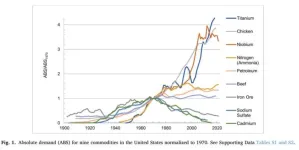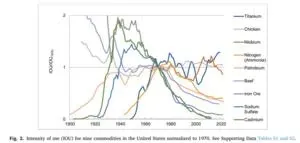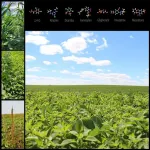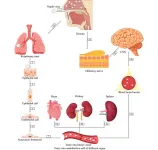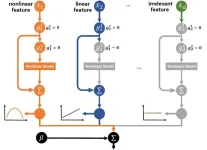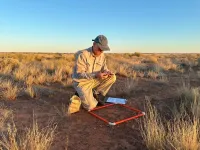(Press-News.org) A new study documents the dramatic change in America’s material diet from 1900 to 2020 – ongoing shifts in US commodity consumption patterns with profound environmental, economic, and geopolitical implications.
Published by Iddo K. Wernick of The Rockefeller University’s Program for the Human Environment in the Elsevier journal Resources Policy, the paper details the consumption of 100 key commodities used to build cities, power cars, produce everyday products, and connect people. It charts transformative changes since the start of the 20th century in both absolute commodity demand (ABS) and demand compared to economic activity, called intensity of use (IOU).
And it concludes that, for much of the 20th Century, ABS for nearly all 100 materials grew steadily as did IOU for many of them. But the decoupling trend began around 1970 – coincidentally, the year in which Americans observed the first Earth Day.
Comparing ABS and IOU from 1970 to 2020, clear differences emerge: For many metals and minerals, the intensity of U.S. commodity use dropped. While some of this decline may owe to production shifting to other countries, the inclusion of 100 commodities demonstrates broader factors at play as well.
For 51 materials, consumption grew but more slowly than the economy, with per-person use of many basic materials staying about the same. For a small group of 8 materials, including three high-tech “vitamins” (rhenium, indium, gallium), consumption grew faster than the economy from 1970 to 2020.
By looking at a wide range of materials over time, the work creates a way to better understand whether industrial societies are using relatively fewer physical materials to support their economies.
And, while this study focuses on the United States, it points the way for all countries to understand the materials their economies rely on and what this means for the environment, economic strength, and security.
“For much of the 20th century, America's appetite for materials seemed insatiable,” says Dr. Wernick. “From the steel that built skyscrapers to the petroleum fueling the automobile revolution, demand for key commodities outpaced economic growth.”
Post-World War II industrial expansion saw aluminum, plastic, and other modern materials supplant traditional ones like iron and timber, enabling lighter, more efficient products, he notes.
“Constant change is here to stay, and the 1970s were pivotal, after many decades of unchecked growth in commodity demand. Slowdown accompanied maturation of infrastructure, growing environmental awareness and efficiency, and the shift from an economy based on extractive industries and manufacturing to one increasingly dominated by services.
America’s changing appetite for commodities
The study divides commodities into three groups based on consumption trends between 1970 and 2020. In the first group, only 8 commodities saw demand rise faster than economic growth. In addition to the trio of metals important for superalloys already mentioned, this group includes the high-tech metal titanium, essential for aerospace and military applications. It also includes the high-tech protein, chicken, whose production soared thanks to efficiencies in poultry farming and dietary shifts.
The second group, 51 in all, consists of commodities that grew more slowly than the economy but still increased in absolute terms, such as petroleum and nitrogen fertilizers. These commodities offer an example of material use decoupled from economic growth, a phenomenon called "relative dematerialization," and may auger that the USA is passing peak oil, peak paper, and peak beef.
Then there are 41 commodities like iron ore, cadmium, and sodium sulfate whose demand declined in both absolute and relative terms. Some, like cadmium, mercury, arsenic, and asbestos fell out of favor due to environmental and health regulations, while others, like sodium sulfate, suffered from industry shifts such as the decline of glass container manufacturing. Astonishingly, the data show that the USA has passed peak water withdrawal.
“The decline in demand for some commodities underscores how technological and societal changes reshape material consumption,” says Dr. Wernick. “Demand for iron ore, for example, once the backbone of the U.S. steel industry, plummeted as electric arc furnace technology made it easier to recycle scrap metal, reducing reliance on mined ore and metallurgical coal.”
Similarly, the fall in sodium sulfate—used in detergents and glassmaking—illustrates the impact of shifts in consumer behavior and industrial priorities. Plastic bottles, for instance, largely displaced glass as the preferred beverage container, while energy-intensive production processes faced mounting pressure from rising costs and environmental regulations.
Data on the industrial consumption of lithium and rare earth elements in the United States show steady, surprising decline. As for several other commodities, Americans now consume the vast majority of their lithium and rare earth elements in imported products they consume, for instance as batteries or magnets. These commodities exemplify the offshoring of US heavy industry and the globalization of supply chains. In contrast, enormous US exports of agricultural products exemplify the opposite: the USA effectively exports cropland, water, and fertilizers and yet cropland and water are in Group 3 (ABS & IOU fell) and nitrogen and potash in Group 2 (ABS rose but IOU fell).
Dematerialization
Is America truly using relatively fewer materials? The study reveals a nuanced picture.
For many high-volume commodities like coal and iron ore, absolute demand has indeed fallen. For others, demand has decoupled from economic growth, growing more slowly than GDP.
Along with the shift of the American economy towards services, the decoupling suggests increasing efficiency in how materials are used. Advances in manufacturing, recycling, and technology have allowed us to do more with less. The study cautions against over-optimism, however, as the "Jevons paradox" looms large: increased efficiency can rebound through affordability and abundance in greater overall consumption, offsetting environmental gains.
The paper also emphasizes that the growing complexity of manufactured products raises the costs associated with isolating and recovering materials from used products. And, “Market success of renewable energy, electric vehicles, and batteries would redraw the global map of material demand,” says Dr. Wernick.
The study points to American successes in reducing consumption, like the 55% drop in coal use between 2007 and 2021, driven by the switch to cleaner natural gas, as proof that large-scale change is possible. It also highlights the potential of increasing the share of nuclear energy to reduce material consumption in the US and even dematerialize hydrogen production, a favorite of futurists and technological purists alike. Increases in agricultural productivity through precision agriculture also promise future material reductions.
Says Dr. Wernick: “As the 21st century unfolds, the question isn’t just how much material we consume but what we use and how wisely we use it.”
“Technological leapfrogging is widely predicted but only time will tell whether developing nations will be able to avoid the USA’s – and now China’s – material-intensive growth pattern.”
Concludes Jesse Ausubel, Director of the Programme for the Human Environment at The Rockefeller University: “Dematerialization has been a focus of our Programme’s research for decades and the scope of this paper – 100 commodities, in many cases over 100 years – offers extraordinary insight into the past and future of what we like to call ‘demandite’ the stuff of modern life.”
“Anyone ordering goods online knows that we need Ozempic not just for the human body but for the human economy. Wernick’s paper shows the USA may finally be finding ways to become lean and why it’s hard to stay that way.”
END
The material revolution: How USA’s commodity appetite evolved from 1900 to present
National consumption shifts since 1900: from asphalt and zinc to chickens and gallium: Apparent inflection point for American materialization: 1970 (1st Earth Day)
2025-01-16
ELSE PRESS RELEASES FROM THIS DATE:
Asteroid impact sulfur release less lethal in dinosaur extinction
2025-01-16
Approximately 66 million years ago, the Chicxulub asteroid, estimated to be 10-15 kilometer in diameter, struck the Yucatán Peninsula (in current-day Mexico), creating a 200-kilometer-wide impact crater. This impact triggered a chain reaction of destructive events including a rapid climate change that eventually led to the extinction of the non-avian dinosaurs and in total about 75% of species on Earth. The main culprit is most likely the “impact winter”, which was caused by massive release of dust, soot, and sulfur into the atmosphere, leading to extreme cold, darkness, and a collapse ...
Study shows seed impact mills clobber waterhemp seed viability
2025-01-16
WESTMINSTER, Colorado – 16 January 2025 – Recently published research in the journal Weed Science shows promise for controlling herbicide-resistant weeds in soybean fields by using a seed impact mill at harvest. When installed on a combine, this harvest weed-seed control system (HWSC) mechanically damages weed seeds as they move through the mill to render them non-viable.
Iowa State University Researchers Alexis Meadows and Ram (Ramawatar) Yadav conducted seed impact mill field experiments ...
Study links rising suicidality among teen girls to increase in identifying as LGBQ
2025-01-16
Amid an increase in suicidal behavior among teen girls, new research links this phenomenon to the significant increase in the number of female students identifying as lesbian, gay, bisexual, or questioning (LGBQ).
“This finding suggests that the overall increase in female suicidality is not due to all female students becoming more suicidal, but rather to a larger proportion of students being part of a group that has historically experienced higher rates of suicidal thoughts and behaviors due to social and structural pressures,” says lead author Joseph Cimpian, ...
Mind’s eye: Pineal gland photoreceptor’s 2 genes help fish detect color
2025-01-16
We see color because photoreceptor cones in our eyes detect light waves corresponding to red, green, and blue, while dimness or brightness is detected by photoreceptor rods. Many non-mammalian vertebrates like fish, however, are known to detect color and brightness with the pineal gland, which is part of the brain. An Osaka Metropolitan University research group has further elucidated on how the pineal organ of fish do so.
Previously, the research group led by Professor Akihisa Terakita and Professor Mitsumasa Koyanagi of the Graduate School of Science revealed that ...
Nipah virus: epidemiology, pathogenesis, treatment, and prevention
2025-01-16
Nipah virus (NiV), a zoonotic paramyxovirus with significant human health implications, has garnered considerable attention due to its high fatality rates and potential for human-to-human transmission, posing a global public health threat. Emerging in South and Southeast Asia, NiV is known for its recurrent outbreaks, with a particular focus on its genetic lineages, NiV-MY and NiV-BD, which differ in pathogenicity and transmissibility. The virus, initially isolated in Malaysia in 1998, has since caused outbreaks linked to contact with infected ...
FDA ban on Red Dye 3 and more are highlighted in Sylvester Cancer's January tip sheet
2025-01-16
FDA BANS RED DYE 3 IN FOOD AND INGESTED DRUGS
Citing two studies linking Red Dye 3 to cancer in laboratory male rats, the FDA today revoked authorization for the use of the dye in food and ingested drugs. The move came in response to a 2022 color additive petition. “This is long overdue,” said Tracy Crane, Ph.D., RDN., director of Lifestyle Medicine and Prevention at Sylvester. “Red Dye 3 has been banned for use in cosmetics and topical drugs for more than three decades,” she said. “Yet it gives more than 9,000 foods in the United States their red coloring. These colorful foods and drinks are particularly appealing to young children,” ...
Mapping gene regulation
2025-01-16
KYOTO – An international team of researchers has taken an important step toward understanding how gene expression is controlled across the human genome. A new study has comprehensively analyzed “cis-regulatory elements” (CREs), which are the DNA sequences that regulate gene transcription. This work sheds light on how these elements contribute to cell-specific gene expression and how mutations within them may influence health and disease.
CREs, including enhancers and promoters, are essential for controlling when and where genes are ...
Exposure to air pollution before pregnancy linked to higher child body mass index, study finds
2025-01-16
In a study of more than 5,000 mothers and their children, exposure to air pollution during the three months before pregnancy predicted higher child body mass index (BMI) and related obesity risk factors up to two years of age. Findings from the study, which was supported by the National Institute of Environmental Health Sciences, were published in the journal Environmental Research.
Past research has linked air pollution exposure during pregnancy to a broad range of health problems in children, including respiratory ...
Neural partially linear additive model
2025-01-16
Interpretability has drawn increasing attention in machine learning. Partially linear additive models provide an attractive middle ground between the simplicity of generalized linear model and the flexibility of generalized additive model, and are important models for addressing the two interpretability problems of feature selection and structure discovery. The existing partially linear additive models still have various imperfect performances in terms of fitting ability.
To solve the problems, a research team lad by Han LI published their new research on 15 December 2024 in Frontiers of Computer Science co-published by Higher Education Press and Springer Nature.
The ...
Dung data: manure can help to improve global maps of herbivore distribution
2025-01-16
Researchers have used dung records to create high-resolution maps of herbivore distribution around the world. Their new study, recently published in Nature Food, reveals a strong positive relationship between dung presence and grazing pressure, meaning the amount of dung found in a particular location could help us understand approximately how many herbivores live there.
Many people consider dung simply as the manure left behind by horses and cows at country shows, or something to be avoided when you visit the cousins’ farm. But dung is actually an important resource for millions of people worldwide.
Dung ...
LAST 30 PRESS RELEASES:
University of Oklahoma researcher awarded funding to pursue AI-powered material design
Exploring how the visual system recovers following injury
Support for parents with infants at pediatric check-ups leads to better reading and math skills in elementary school
Kids’ behavioral health is a growing share of family health costs
Day & night: Cancer disrupts the brain’s natural rhythm
COVID-19 vaccination significantly reduces risk to pregnant women and baby
The role of vaccination in maternal and perinatal outcomes associated with COVID-19 in pregnancy
Mayo Clinic smartwatch system helps parents shorten and defuse children's severe tantrums early
Behavioral health spending spikes to 40% of all children’s health expenditures, nearly doubling in a decade
Digital cognitive behavioral treatment for generalized anxiety disorder
Expenditures for pediatric behavioral health care over time and estimated family financial burden
Air conditioning in nursing homes and mortality during extreme heat
The Alps to lose a record number of glaciers in the next decade
What makes a good proton conductor?
New science reporting guide published for journalists in Bulgaria
New international study reveals major survival gaps among children with cancer
New science reporting guide published for journalists in Turkey
Scientists develop a smarter mRNA therapy that knows which cells to target
Neuroanatomy-informed brain–machine hybrid intelligence for robust acoustic target detection
Eight SwRI hydrogen projects funded by ENERGYWERX
The Lundquist Institute and its start-up company Vitalex Biosciences Announces Strategic Advancement of Second-Generation fungal Vaccine VXV-01 through Phase 1 Trials under $40 Million Competitive Con
Fine particles in pollution are associated with early signs of autoimmune disease
Review article | Towards a Global Ground-Based Earth Observatory (GGBEO): Leveraging existing systems and networks
Penn and UMich create world’s smallest programmable, autonomous robots
Cleveland researchers launch first major study to address ‘hidden performance killer’ in athletes
To connect across politics, try saying what you oppose
Modulating key interaction prevents virus from entering cells
Project explores barriers to NHS career progression facing international medical graduates
Jeonbuk National University researchers explore the impact of different seasonings on the flavor perception of Doenjang soup
Two Keck Medicine of USC Hospitals named Leapfrog Top Teaching Hospitals
[Press-News.org] The material revolution: How USA’s commodity appetite evolved from 1900 to presentNational consumption shifts since 1900: from asphalt and zinc to chickens and gallium: Apparent inflection point for American materialization: 1970 (1st Earth Day)
